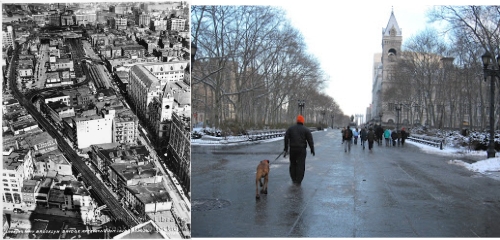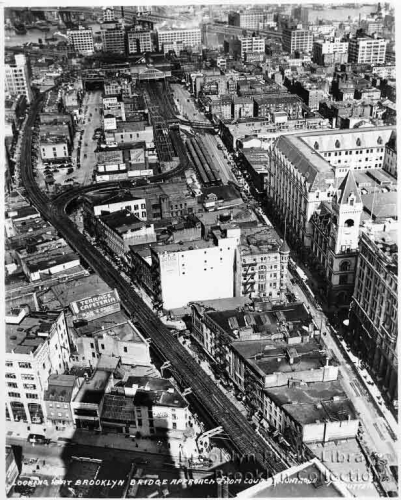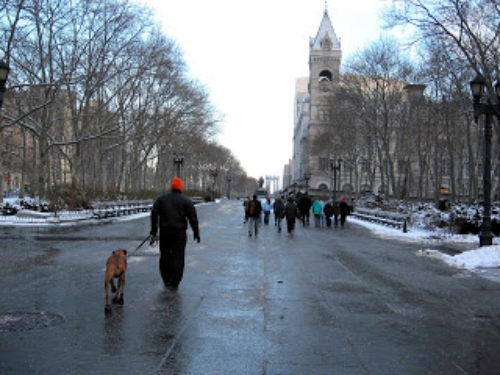Past and Present: Aerial View of Cadman Plaza
Photo by McBrookyn A Look at Brooklyn, then and now. Atlantic Yards, the high rises on Flatbush Avenue, the changes in Downtown Brooklyn: these projects have certainly altered the streetscapes and silhouette of Brooklyn. But they don’t hold a candle to the changes that took place when Cadman Plaza was created. Most of us either…


Photo by McBrookyn
A Look at Brooklyn, then and now.
Atlantic Yards, the high rises on Flatbush Avenue, the changes in Downtown Brooklyn: these projects have certainly altered the streetscapes and silhouette of Brooklyn. But they don’t hold a candle to the changes that took place when Cadman Plaza was created. Most of us either grew up or moved here long after the Plaza was created, so what we see on a daily basis now has a comfortable familiarity. The trees in the park have reached full growth. The benches, monuments, statues and buildings have all gained the patina of age that the city bestows. We can’t imagine anything else. That is, until we see the photographs.
The aerial photograph of the Cadman Plaza area (above and below) was taken in 1935, and what a difference. It was taken from about Court Street and Montague Street. Borough Hall and the old court house are just outside of the photograph. The view looks out towards the bridge. There are two big stories here, shown graphically in black and white. The first is the presence of the elevated train lines. For fifty-some years these tracks cut through Downtown Brooklyn from the Brooklyn Bridge and then up Fulton Street, running right by Borough Hall.
The closest experience you can find today to what downtown must have been like is the busy shopping corridor beneath the J train on Broadway on the Williamsburg-Bushwick border. Only it would have been even worse in the early 20th century since those trains gave off much more pollution from smoke and ash. The Sands Street terminal was the last terminal on the Brooklyn side, and was a huge transit stop. It can be seen at the top of the photo, just underneath the factory buildings. Almost at the center of the photo, a rail yard with stored trains can be seen.
With the exception of the post office, prominent at the center right side of the photograph, and some of the factory buildings far to the back in Dumbo, everything else in this photograph is now gone. That’s a lot of gone. The Cadman Plaza project was the largest urban, civic center project to be completed in the city after World War II, although it was started well before the war. This photograph was probably taken to document the destruction that would soon follow.
By 1936, buildings closer to the Brooklyn Bridge began to come down in order to widen the roadways to the bridge. In the early 1940s the elevated train tracks began to come down, and by 1944 the tracks and terminals were all gone, opening up the entire downtown area. The plans for the civic center, as well as the memorials, the parks and later, the housing, were being developed. By the early 1950s, the entire area shown in this photograph was razed, leaving only the post office. The entire Cadman project was completed before the decade was out. There are, of course, many side stories to the building of Cadman Plaza, and it’s rather fascinating. In one enormous project, the entire municipal area of the city was permanently changed.
Today, as seen in the modern photograph, we have a huge extended park flanked on all sides by new courthouses, housing and municipal buildings. There is now a vast expanse of parkland all leading to the new approaches to the Brooklyn Bridge. The trains are now all underground. We lost some great buildings in the process, and closer to the bridge viable neighborhoods were eliminated. As always happens, little thought was given to the details, and the entire area was felled like a hand clearing off a table.
It’s rather amazing the post office is still here — the only 19th century building in the footprint to survive aside from Borough Hall. But all in all, few would argue that Cadman Plaza was a bad idea. In the middle of urban hustle and bustle, parkland, open spaces and places to gather and rest are good and necessary things, and the Plaza is being enjoyed by more and more people every year. GMAP











What's Your Take? Leave a Comment